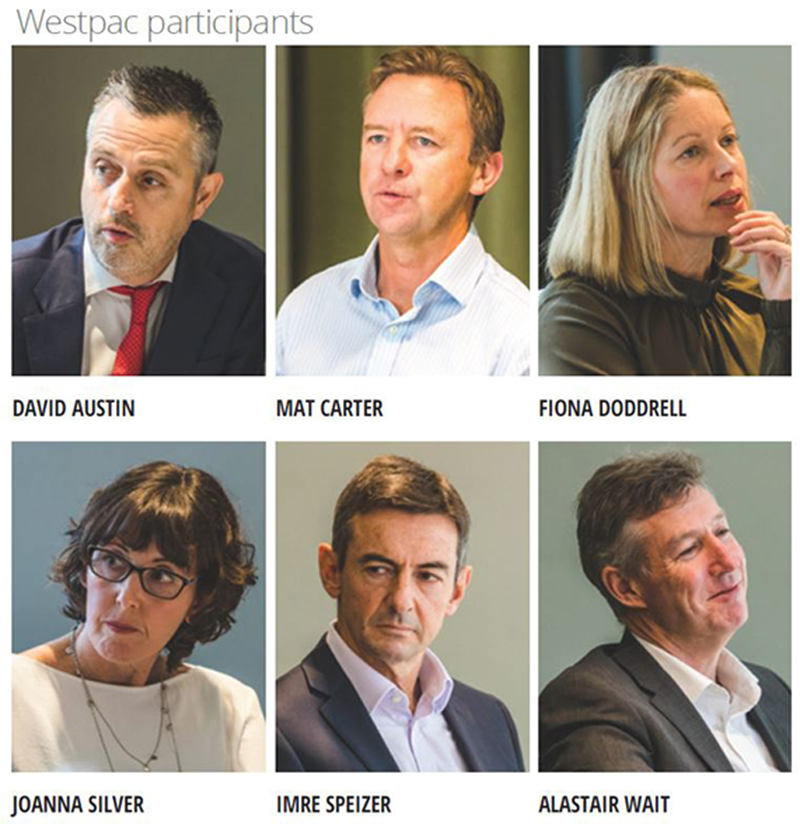
Back on track in the New Zealand high-grade market
At the start of June, KangaNews and Westpac brought together New Zealand’s biggest government-sector issuers in Wellington to discuss the path of their market from the depths of the crisis back to functionality, the new challenges of 2021 and the outlook for a raft of factors – including sustainable-finance evolution, inflation-linked issuance and the long-dated market.

THE ROAD TO NORMALITY
Davison When we held this roundtable roughly a year ago we were already talking about better-than-expected outcomes from the COVID-19 crisis, albeit at the time largely in the sense that market functionality had returned. Conditions have improved still further from then, but what have been the markers on the road to recovery?
WAIT Initially, we were looking at a massive government debt programme – NZ$1 billion (US$706.8 million) of issuance a week. Everyone was wondering how we were going to get this done.
The introduction of the RBNZ [Reserve Bank of New Zealand] LSAP [large-scale asset purchase] programme was the injection of confidence the market needed, after which investor behaviour became more rational. Bond tenders were all well supported, the secondary market was operating efficiently and, with the economy doing better than most expected, tender issuance fell reasonably quickly. This was good evidence that we were on the road to recovery.
On the economic story, I think of the first unemployment number we saw after the onset of the pandemic. It was massively better than we had been expecting and started to give some evidence of the resilience of the NZ economy. Given the wide-ranging government assistance available, confidence grew that we could avoid the worst-case economic scenarios.
MARTIN For us, the marker was the first new bond deal we did – the 2024, issued in June. We purposely chose a short-dated bond that would capture bank balance-sheet demand. Even so, we were pretty pleased to get a book of about NZ$14 billion from which we issued NZ$7 billion. This was our largest-ever deal and it started to build our confidence. This led us to issue the 2041 – clearly a riskier, longer-dated deal.
From there, it was the pre-election fiscal update in September. This was not long after the May budget but we were already able to revise down the forecast annual New Zealand government bond (NZGB) issuance programme number from the NZ$60 billion we first thought it was going to be.
It has been a story of confidence in two respects – on market function and the ability to get deals away, and then on the economic and fiscal side, that things might not be as bad as initially thought.
LE QUESNE Economic activity, employment and health outcomes have been much better than expected. This is a combination of fiscal- and monetary-policy stimulus as well as rapid virus containment.

The reserve bank began by responding through traditional tools, cutting the OCR [official cash rate] by 75 basis points to what was effectively the lower bound at the time, as well as large injections of liquidity through FX swaps.
However, we could see that market stress was continuing to be very, very heightened in bond markets. Cash was king, yields were high and volatile and, at times, there were no bids at all in New Zealand government bonds. Our Monetary Policy Committee (MPC) assessed that more stimulus was required and so on 23 March we announced the LSAP programme. Its purpose was twofold: to lower interest rates and to support market functioning. We immediately saw yields and credit spreads start to stabilise and decline, bids and offers returning and spreads narrowing.
We viewed the extent to which the market bounced back as critical and as a sign of its resilience, given that we rely on well-functioning markets and confidence in institutions for the efficient deployment of monetary-policy stimulus.
CARTER I’d like to mention a couple of other market aspects, in this case in the corporate sector. One is that companies were able to find liquidity to support their balance sheets, even if they were under immense pressure. For instance, we saw Auckland Airport conduct an equity raise of NZ$1 billion in April last year – while everyone was in home offices, which itself was a real step change that had never happened before in New Zealand.
This translated into other transactions, too. In fact, a lot of issuers here have had really strong execution outcomes over the past year, obviously helped by the LSAP programme, which stabilised market tone and investor confidence. This sentiment trickled all the way down the credit spectrum, with the second half of the year very busy for rated and unrated corporates alike.
AUSTIN For me, a momentous marker last year – endorsing how the market had progressed – was the flurry of long-dated issuance in Q3, such as Auckland Council’s 30-year bond. This was a transaction issued into a market that doesn’t have an underlying government bond or an active swap market to that tenor.
We also saw 10-year transactions from Powerco and Goodman Property at a similar time, both of which had broad market uptake including offshore involvement – which rubber- stamps market confidence. A market that is back on its feet is one that can sell credit at 10 years plus.
BLIGH We were certainly cautious, as investors were still getting to know our credit. We didn’t have a great number of lines, or depth in them. Initially we took confidence from the LSAP programme and the way in which it normalised spreads, which gave us confidence to come to market. We had also observed New Zealand Local Government Funding Agency (LGFA)’s issuance, which provided further confidence.
We had a specific funding requirement and we were also supporting the national recovery, which made for a lot of trepidation about issuance. We had moved to same-day payment terms for our suppliers and were supporting our partners in other ways, for instance.
As the year progressed and we saw global support for capital markets, we discovered that markets were awash with liquidity. This gave us confidence that, when we issued in late 2020, we could extend our curve out to 2035. We priced inside initial guidance and this set up our bond tender programme.

BUTCHER I would also call out the LSAP, as well as both the introduction of LGFA into the programme that ensured market stability and the fact that the eventual withdrawal of LGFA didn’t bring about a taper tantrum. There was also no disruption with the removal of the TAF [term auction facility].
It is important not to underestimate the importance of the New Zealand sovereign credit-rating upgrade, 11 years after the country was downgraded and under some unique circumstances. This demonstrates the strong financial position going into the crisis, but also the resilience and policy actions that eventually occurred.
Another observations is KBN [Kommunalbanken Norway] being the first of the high-grade issuers to borrow at flat to swap in the two-year part of the curve. Most of us around the table are now issuing at sub-bank-bills levels in short dates, which is a unique situation highlighting the substantial liquidity in the system. The lack of new-insurance premia in recent syndications shows the market is back to pre-COVID levels.
BISHOP We improved our cash position as much as we could. We were initially limited to short-term funding with a maximum maturity of two years, which at the time was pretty expensive. However, as conditions stabilised, the LGFA was issuing fairly easily and we tapped the LGFA vehicle frequently during the course of last year.
By the end of the year, cash flow had improved against our forecast and the revenue hit wasn’t as bad as we had predicted. Our requirements were therefore reasonably modest, and in the last six months a lot of money has been available domestically and offshore. We did not access offshore markets in 2020 and in fact we have not done so for more than 18 months. Aside from our own-name domestic green bond, most of our issuance in 2020 was executed via the LGFA.
We normally separate interest-rate from funding risk, but with outright interest rates so low our idea was to go as long in duration as we could and agonise less about the credit margin. Our thinking was that 30 years at sub-3 per cent, if we think inflation will be on average 2 per cent in the longer term, results in an expected real cost of funds of less than 1 per cent. We couldn’t really do this in offshore markets given we couldn’t get a 30-year cross-currency swap.
The missing linker?
With inflation expectations back on the minds of market participants, a boost in demand for inflation-linked product might be expected to follow. So far, this has not come to pass in New Zealand.
MARTIN When we reinstated our inflation-indexed bond offering back in 2013, buyers were largely investors with long-dated liabilities. Over the last eight years, the market has matured to the extent that most domestic fund managers now participate, at times, as well as global institutional investors and hedge funds.
The demand base is definitely becoming more diverse. However, we are still in the early stages of inflation being on the radar of underlying investors. Due to where we have come from in the inflation cycle, the fear factor that drives demand for inflation product doesn’t yet seem very present.
At the moment, we are balancing what we consider to be the minimum volume of issuance to balance market presence with not wanting to oversupply the market with issuance.
MARKET CONDITIONS AND ESG
Davison We are increasingly seeing an interesting intersection between market liquidity and sustainable finance. What is driving uptake in New Zealand?
SILVER It certainly doesn’t seem to be demand-side driven in New Zealand yet, though some recent transactions have shown that institutional investors are sending stronger signals on ESG [environmental, social and governance] aspects – they are saying ‘no’ more and are asking more pressing questions of issuers.
The drivers and pressures are coming from a lot of different places. There is stakeholder engagement, media, legal risk on directors, regulatory drivers around climate-risk disclosure, the Climate Change Commission, budgets and many more.
Offshore, in the oil sector for example, there is climate litigation – in the form of European courts telling companies to divest faster from fossil fuels. In addition, boards of global oil companies like ExxonMobil and Chevron are being forced by climate activists and disgruntled institutional investors to swap out commercial directors for climate-minded hedge funds or to cut greenhouse emissions faster.
My sense is that, while there is a divergence across the local market when it comes to investor engagement and integration in ESG, the waves of ESG change from investors in Europe will ripple strongly onto New Zealand shores.
BAKER Kāinga Ora – Homes and Communities is a government-owned social enterprise and we are currently at the beginning of the largest urban redevelopment construction programme in New Zealand in generations. Our debt programme is to finance assets that will provide social support and a safety net for the most economically and socially vulnerable New Zealanders. As such, we are already in a socially driven space. We also have a very strong environmental sustainability offering.
As a borrower, we are in the market at very close to government-bond rates and are looking to differentiate ourselves for investors that are interested in financing social and environmental outcomes.
We haven’t had a situation of the finance team wagging the dog on sustainability. On the back of Kāinga Ora having a strong sustainability offering, our board and chief financial officer have recognised this as an opportunity to link financing to the organisation’s climate-change-related goals.
However, sustainability-linked financing has been a strong enabler of our sustainability programme and goals. It brings the discussion at the executive level from a different perspective and ensures that a long-term view on the sustainability of our assets is taken. If we can’t demonstrate we are building assets that reduce our carbon footprint and are resilient, it will become increasingly difficult to refinance. With all the goodwill in the world, without the money we can’t deliver the difference.
DODDRELL A corporate chief financial officer summed it up well recently. He commented a year ago there were requests from boards to engage in sustainability. Now they are demanding to engage. Organisations moved quickly last year to bring costs under control with the goal of shoring up liquidity. Now they are in a strong position to link sustainability into their financing.
The announcement this morning that New Zealand needs to spend more than NZ$185 billion on water is just one example of the infrastructure task this country is facing. It is abundantly clear that we will require access to different pools of sustainable finance, including via the debt capital market and structured markets, to finance these initiatives.
RBNZ IN DEPTH
Davison How successful have the RBNZ’s various specific measures been at achieving their stated goals?
LE QUESNE The combination of monetary-policy and liquidity-backstop tools alongside fiscal stimulus and health containment contributed to better-than-expected outcomes in New Zealand.
The MPC decides how much stimulus is required and uses the principles for monetary-policy tools – which relate to efficiency, effectiveness and impact on the financial system – to decide how the stimulus is deployed.
Chapter three of the monetary-policy statement talks in depth about the stimulus channels and tools at hand. The OCR works through traditional channels such as interest rates and the exchange rate, while the LSAP also has market-functioning and portfolio-rebalancing effects.
Recently, the MPC noted that the OCR will be the primary tool going forward while LSAP and funding for lending are less likely to be as effective and efficient if scaled up in the current environment. The OCR is quick to deploy and unwind.
The LSAP programme remains at a limit of NZ$100 billion to June 2022. However, the MPC is mindful of volume constraints around the programme and also acknowledged that, based on current projections of government-bond issuance, it would not be able to reach the limit by the end of the programme.
SPEIZER I think the RBNZ delivered a master class in central banking in 2020. The bank had the offshore experience with previous bouts of QE and crises to draw on, and would have known that the key was to go hard and early.
The LSAP programme started off at NZ$1.8 billion per week, which proved to be its peak. Our modelling estimated that over the first six months it was worth around minus 100 basis points to the 10-year bond yield, which is similar to the RBNZ’s own modelling of minus 50-100 basis points.
The reserve bank has reduced the weekly pace of asset purchases to around NZ$300 million currently, and the market will be aware the expiry date is June 2022. We expect weekly volume to continue to diminish. The benefit of this gradual run-off is that markets have probably extrapolated and already priced in the tapering. This means a taper tantrum is unlikely – which is in contrast to offshore markets, which remain sensitive to such.
The RBNZ has signalled that the LSAP will now take a back seat and that it will focus on the OCR, meaning the market’s gaze is now off the LSAP. The entire approach has been very well managed and the approach to exit equally so.
WAIT RBNZ intervention almost worked too well. The combination of the negative rates lure with the aggressive LSAP programme took our 10-year curve to 40 basis points below Australia and 35 basis points below the US. Surprisingly, this didn’t bring about a lot of selling from offshore. But in some ways it dragged our curve lower in a way that incentivised longstanding offshore investors to look at other markets.
Davison The RBNZ flagged future OCR hikes in its May statement. Was it a surprise to see this so soon?
SPEIZER Yes, we were surprised. However, it appears that this did not represent an abrupt shift in economic outlook but rather that the RBNZ’s confidence in its forecasts has grown, such that it was appropriate to reveal a rising OCR track.
As to the first hike date, there is a range of expectations among the analyst community, with Westpac’s forecast slightly later than the median. Our main point of difference is that we do not expect wage inflation to be as high as the RBNZ has forecast. But we won’t know the truth until early next year.
SUPPLY OUTLOOK
Davison New Zealand Debt Management (NZDM)’s latest funding update surprised some who were expecting a further reduction in issuance from the forecast NZ$30 billion for 2021/22. How has the market responded?
MARTIN On the day there wasn’t a notable market move. However, anecdotal feedback was that some were surprised we hadn’t revised our programme down further. Market users have been tracking the improvement of the economic outlook and fiscal revenue, but equally may not have anticipated some increase in government expenditure. In addition, over and above funding the cash deficit, we have discretion around the level of liquidity buffer we maintain. We are choosing, at the moment, to keep this reasonably high.
Davison How much has confidence around the funding forecast improved in the last 12 months? Is it back to business as usual or is there still an element of the unknown?
MARTIN There is still a greater level of uncertainty, which is part of the reason we are maintaining a prudent liquidity position. I hope we will return to a more normal environment over the course of time.
BLIGH As an issuer with a growing financing requirement, the demand-supply imbalance works in our favour because of the scarcity of Housing New Zealand bonds on issue. It is hard to say where the tipping point might be. Our borrowing protocol limit was recently lifted to NZ$8.3 billion for the next 12 months to account for the construction ahead.
A big part for us is not so much the overall volume but the pace at which we get there. We will be constrained by the physical capacity of being able to deliver homes in a given period.
We have just released our annual borrowing programme for the next fiscal year, of NZ$2.3 billion. This is an approximate volume and we might issue more or less depending on market conditions – specifically capacity constraints but also our ability to access land and other things that contribute to being an urban developer.
BUTCHER Our bond issuance last year was at a record level and yet we achieved tighter issuance spreads. This year, subject to council borrowing requirements, we are reverting to a more normal level of issuance. Our funding programme is forecast to be NZ$2.9 billion, down from last year’s NZ$3.7 billion.
I think we are returning to normality, albeit with higher interest rates and tighter spreads. For LGFA, the unknown is less about government-bond supply and more about Kauri-market issuance dynamics. Our bonds tend to be a place for investors to park cash until a Kauri issue comes along.
Davison In 2020, NZDM was obviously issuing a lot more but RBNZ purchases were a significant offset on the demand side. The RBNZ’s actions will not necessarily be aligned with borrowing requirements going forward. How is the market thinking about a change in supply-demand dynamics, and what might it mean for bond yields?
SPEIZER Looking at LSAP versus government-bond issuance, the RBNZ has bought more than has been net issued. Over the next 12 months, we expect the reverse – since we expect the RBNZ to taper weekly purchases even further. This said, we also expect Treasury to reduce its NZGB programme to NZ$20 billion from NZ$30 billion. The net effect on yields could be modest, if any.
Our early modelling estimated that LSAPs were twice as powerful, dollar for dollar, as issuance. This suggests that the LSAP can be below issuance pace without adversely affecting markets.
In addition, markets are usually soothed by the mere existence of central-bank intervention programmes – even if the programmes are not being tapped. The LSAP programme has an end date of June 2022 and it should have some supportive effect even if it is not being deployed.

Davison To what extent do supply dynamics factor into the RBNZ’s thinking about the scale of its intervention?
LE QUESNE The level of stimulus, as well as its deployment, is decided by the MPC. The committee has decided to leave the LSAP programme at a limit of NZ$100 billion out to June 2022. The RBNZ’s financial markets department will decide week-to-week how the programme will be implemented to achieve the MPC’s objective.
Over time, we have substantially decreased weekly purchase amounts partially in recognition of the maturation of the programme as we have started to own greater proportions of individual bond lines on an outright basis. We are mindful of our impact on market functioning to ensure we have a deep and liquid government-bond market – which is important for confidence and stability over the longer term.
From our perspective, demand and supply dynamics play a part, to the extent that they have an impact on market functioning – and this is mainly what we are monitoring week to week.
Davison As a relatively small market globally, more New Zealand bond supply is presumably welcomed by international investors. But has higher issuance spurred capacity concerns?
AUSTIN In principle, the more paper there is on issue the more liquid the market is. But there are also technical factors at play at the moment that affect liquidity.
With issuance, it tends to be a case of ‘build it and they will come’. Domestically, if it goes into an index or fits bank balance-sheet requirements, issuance will generally find a home. Despite increased supply, by contrast, New Zealand remains challenging from an offshore investor’s perspective as our markets don’t naturally fit into global indices.
This said, in the current environment – where New Zealand yields have risen at a quicker pace than the US and Australia – NZGBs offer decent yield pick-up. This has revived some offshore interest and we are seeing buy-and-hold, real-money investors look to accumulate.
CARTER We sometimes struggle to find air time for the ‘New Zealand Inc.’ story as our bond programmes are smaller than our peers. Liquidity remains a focus for investors but larger volume and tranche sizes, as well as more frequent issuance, will mitigate these concerns and we will see more offshore demand for New Zealand dollar paper.
DODDRELL What has been constructive, however, is the positive press New Zealand received coming out of COVID-19. The concept of ‘New Zealand Inc’ has been very well received by many – including, for example, US private placement investors. We will always have challenges globally so it is important that we try to capture the increased positive momentum.
It would be good to build on what our market achieved last year, for example in the form of bringing new names and more supply to market to focus global attention on New Zealand.
Demand dynamics and tenor
In 2020, a number of issuers from the New Zealand government sector took advantage of market conditions to test demand for extended tenor in their bond issuance – most notably Auckland Council, which printed a 30-year green bond. This part of the market is still evolving in scale and liquidity, however.
BISHOP We knew there was some investor demand for long tenor from reverse enquiry. But we were going largely into the unknown and we were pleasantly surprised at the outcome. We initially sought NZ$300 million (US$228.1 million) and we could have printed NZ$700 million. We eventually priced NZ$500 million with strong support from domestic as well as offshore institutions.
SUSTAINABLE FUNDING EVOLUTION
Davison We often talk about Kāinga Ora as a leader in the sustainable funding space. As the sustainable finance market evolves, what challenges is it facing to keep up with the pace of change?
BAKER There are a couple of challenges here, one around timeframes and one around ability to collect information and report. The planning cycle for a medium-sized development project – of 20 houses on site, for example – can be four years. Investing for impact, in other words optimising our investment to deliver the largest impact for the least extra cost, means getting designs right up front and then not backing down on the outcome.
We have been focused on getting up-front decision-making right. But a lot of the good work we have done over the last 18 months won’t begin to be delivered on the ground for at least another year. This is at least a 10-year transformation process and we are still right at the start. There is an obvious challenge: how do we tell our story and maintain credibility with such a long lead time on outcomes?
Sustainability reporting is very immature compared with financial reporting. At the moment, we can report according to outputs – in other words, how many homes we have built and to what construction specification. But when we are talking about sustainability the question becomes how much difference did this make?
The industry is not used to recording information about CO2 and waste, and setting up the processes to record these takes time. More abstract benefits are impossible to measure – how much difference was made to the children who lived in a home that wasn’t cold or mouldy, on things like health, education and future ability to be a productive participant in society.
With these challenges in mind, we have tried to tackle some of the more doable opportunities up front to build credibility. In particular, signing up to 6HomeStar was very audacious at the time. It has had quite an impact already.
However, I suspect that in five years’ time it will not be good enough just to say that we are delivering several thousand green-rated buildings. We will need to be able to say our construction programme initially looked a certain way and the social and environmental outcomes were going to be X, but because of the changes we made the outcomes are in fact Y.
Davison So much of what occurs in sustainable finance is based on an acceptance of a defined premise – for instance that building social housing is a good and lending money to do it is socially beneficial. Going more deeply into impact sounds incredibly complex.
BAKER Some impacts, like volume of CO2 or waste, will become increasingly easy to measure and report on. I expect, at some point, organisations that are still relying on ‘acceptance of a premise’ are in for a shock.
For other impacts, this cuts to the heart of a difficult issue around outcomes and specific perspectives on what a good outcome is. For example, for a provider of social housing, is the better outcome that someone moves into one of our homes and then back to the private market – and thus ‘back on their feet’ – in the shortest time possible? Or is that the family moves into one of our homes, they feel a permanent part of their community and their children never have to move again while they are at school?
SILVER There is another complication – data. We have had financial reporting for many years and we take it as read that these reports align to certain standards and are audited by external reviewers. Sustainability reporting is not standardised or audited, nor is it common to get assurance over sustainability metrics. The Sustainability-Linked Loan and Bond principles both require this now – and providing it is going to require a considerable step-up from New Zealand issuers.
Going forward, it will no longer be sufficient for a borrower to state that the target in a sustainability-linked instrument – loan or bond – is ambitious without better insight into the material issues for that borrower, the data surrounding them and the extent of the strategic commitment to addressing them.
If we start to treat our nonfinancial metrics as equally important as our financial metrics, we can start to raise the game. There will be greater uptake of sustainability-linked instruments this and next year, for sure.
Davison How do the funding and sustainability teams work together at Auckland Council in the sense of making sure that its bonds are best in breed?
BISHOP We work closely together and Auckland Council has frameworks in place to determine which assets will meet the criteria to go in the pool. Our assets are about 20 per cent debt- funded overall. If we are doing what we say we are doing in the sustainability-linked space, we should be able to grow the pool so that all our debt issuance is green.
SILVER We have talked about confidence earlier in this discussion. The extent to which government agencies participate in sustainable debt markets and follow global best practice with their documentation and disclosures is incredibly important to build confidence in these markets.
Issuance by government – whether central or local, or government agencies – definitively helps embolden corporate issuers in the sustainable debt market. Government issuers can demonstrate and drive diversification of sectors issuing sustainable debt and diversification of structures across use-of-proceeds and sustainability-linked instruments.
It will also build confidence among issuers that this is a sector where funding can be raised and that offers value beyond the money they are seeking. It is fantastic that Auckland Council is taking this approach.
BISHOP It took us a couple of years to get comfortable with our position precisely because of concerns around greenwashing.
SILVER According to the Climate Change Commission, New Zealand’s climate transition is going to cost the economy around 1 per cent of GDP, or NZ$34 billion, out to 2035. This changes the dialogue in the sense that it gives permission to certain issuers to prioritise and highlight sustainable assets in relevant sectors for sustainable loan or bond financing, while also warming investors up to the idea of more sustainable debt issuance coming on stream to fund the country’s transition.
Davison This is a pretty positive outlook. But if conditions are supportive of sustainability-themed issuance, why has there not been more of it in New Zealand by this point?
BUTCHER An asymmetry currently exists between issuers and investors in the New Zealand sustainable-finance market. There is a cost of establishing a programme, identifying assets and ongoing reporting while, in the current absence of any ‘greenium’, issuers in New Zealand bear these costs without receiving financial benefits.
Meanwhile, investors are demanding GSS [green, social and sustainability] bonds to ensure they meet their client demands or pressure from asset consultants that are increasing weight on evaluating fixed-income managers on their ESG scores. This imbalance between costs and benefits needs to be addressed to encourage more high-grade issuers to access, and therefore open up, the market.
BAKER I agree that it is not cheap to do the reporting. But I also believe the information we need to generate for sustainability reporting is information the organisation needs to have anyway – to support good decision-making.
In the conversations with our treasury team, we are trying to build a process whereby the organisation generates information that allows our leaders to make effective decisions. This information is then available to our treasury and external reporting teams to put into a reporting framework for our sustainability bonds.
DODDRELL This is an interesting dynamic because, while investors might be very vocal about ESG requirements, it is true that most of the work to actually deliver these instruments falls to the issuer.
In regard to financial benefits, it is worthwhile to look to Europe – which has led the way in this area. Germany is obviously one of the largest sovereign issuers globally, and its approach is interesting. It is ensuring that all its green bonds have the same maturity date as a vanilla bond. The benefit of this is that it can not only track performance but can also offer its investors genuine choice. At the moment there is a roughly 2 basis point differential.
MARTIN We are less concerned about cost and more focused on making a meaningful contribution. A consideration for us has been that, under the current fiscal-management approach, the government makes expenditure decisions and after this we come along to fund them.
We have been challenged by sophisticated ESG investors offshore that have told us not just to issue a green bond against existing expenditure decisions but do something more ambitious and inventive. At the moment, our approach is holistic. We have generic bond products but shine a spotlight on government activities such as the wellbeing budget.
We are working with our public-sector colleagues on how initiatives in the financial sphere can support the government’s response to the Climate Change Commission’s report.

SILVER There is a lot to shine the spotlight on. The government is still funding a significant proportion of the COVID-19 recovery as well as announcing some fantastic initiatives to address social and environmental challenges including the climate transition.
Where these activities and assets are new and they meet global sustainable-finance principles including, where applicable, the more stringent Climate Bonds Initiative criteria, we argue that more sustainable financing is exactly what New Zealand needs. We need to finance significant volume of debt in a range of sectors to achieve these ambitious but necessary goals.
This said, to be clear, older and still operational assets such as renewable-energy assets that are 60 or 70 years old can still have a useful life and be delivering emission reduction. Therefore it is perfectly appropriate for them to seek green-bond funding, as we have seen in the local market – for example with Meridian’s greening of its borrowing programme.
BAKER Kāinga Ora is investing some NZ$3 billion into housing each year. We also procure about 7 per cent of New Zealand’s construction services in a market worth around NZ$20 billion a year. By 2050, it is possible that NZ$600 billion will have been spent on new construction.
We could spend this money on assets that are designed for the past or we could spend it on assets that are fit for the future. The long-term cost of delivering this programme in a future-fit way might be 5 per cent. But the cost of retrofitting it later will probably be 105 per cent.
Coordination and optimisation across the sector is required to achieve this. However, most of the decisions to invest aren’t coming from government. We need the private market, which will be undertaking the majority of the development, to decide to incur the extra cost now to fund something that is better in the future.

HIGH-GRADE ISSUERS YEARBOOK 2023
The ultimate guide to Australian and New Zealand government-sector borrowers.













